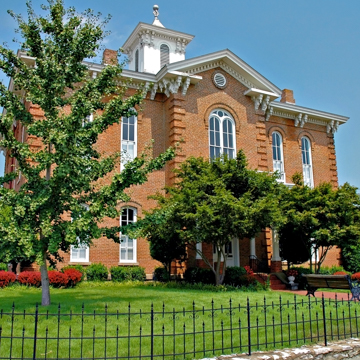Pocahontas developed in the 1820s as a port on the Black River and became the seat of Randolph County when it was created from Lawrence County in 1835. This attractive Italianate courthouse, built by contractor John A. McKay, was constructed on the site of the county’s first courthouse of c. 1837, which had collapsed. The two-story red brick building’s central bay projects slightly and is emphasized by a pedimented gable and a small wooden porch painted white. The hipped roof’s deep eaves are supported by prominent paired brackets, chimneys dot the roofline, and a tall square cupola is a notable feature. All the windows are tall and narrow, and their round-arched tops feature corbel-arched headers. In 1940, courthouse functions were relocated to a new WPA-funded building of buff brick at W. Broadway and N. Marr streets, which was designed by Eugene J. Stern. The old courthouse’s interior was altered for subsequent tenants. It now provides space for the Randolph County Chamber of Commerce and the county’s tourist board.
You are here
Old Randolph County Courthouse
If SAH Archipedia has been useful to you, please consider supporting it.
SAH Archipedia tells the story of the United States through its buildings, landscapes, and cities. This freely available resource empowers the public with authoritative knowledge that deepens their understanding and appreciation of the built environment. But the Society of Architectural Historians, which created SAH Archipedia with University of Virginia Press, needs your support to maintain the high-caliber research, writing, photography, cartography, editing, design, and programming that make SAH Archipedia a trusted online resource available to all who value the history of place, heritage tourism, and learning.


